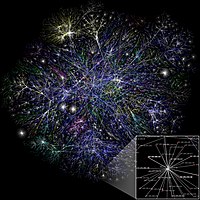
Photo from wikipedia
The percolation model of electrical conductivity of a two-component medium, formed by a mixture of conductive small and non-conductive large particles with the adhesion of small particles to the surface… Click to show full abstract
The percolation model of electrical conductivity of a two-component medium, formed by a mixture of conductive small and non-conductive large particles with the adhesion of small particles to the surface of large ones and subsequent mixture compaction, is suggested. The model describes two main aspects. The first is a strong lowering of percolation threshold as a result of segregation of the conductive component on the non-conductive particle surface. The second is the calculation of the critical indices describing the power-law dependence of conductivity on composition as a consequence of percolation effects on the surface conductivity of large particles. Surface conductivity arises due to segregation of the conductive component and leads to threshold in a three-dimensional grid of conductive surfaces.
Journal Title: Journal of Materials Science
Year Published: 2020
Link to full text (if available)
Share on Social Media: Sign Up to like & get
recommendations!